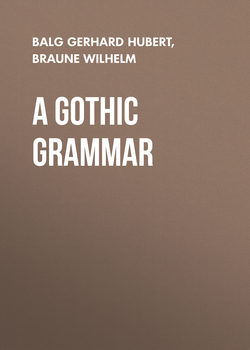Читать книгу A Gothic Grammar - Braune Wilhelm - Страница 17
FONOLOGY
CHAP. IV. THE CONSONANTS
APPENDIX
GENERAL REMARKS ON THE CONSONANTS
Оглавление§ 79. The Gothic soft spirants, b, d, z, finally and before the s of the nom. (cp. §§ 56. 74. 78) ar changed into the corresponding hard sounds, f, þ, s, while the fourth soft spirant, medial g, remains unchanged when final (§ 66; § 65, n. 2).
Note 1. Also the final b, d, z hav sumtimes remaind unchanged, i. e. z rarely (§ 78, n. 1), but b and d especially often in certain parts where also other forms show a later stage of development. Cp. § 56, n. 1; § 74, n. 1, and Zs. fda., 25, 226 et seq.
Note 2. Interchange between f and b, þ and d, h and g, s and z, which had taken place in proethnic Germanic according to definit laws and is better preservd in other Germanic languages ('Grammatical Change'; s. ahd. gr., § 100 et seq.), occurs in Gothic only in derivativ words; cp. g-h, § 66, n. 1; d-þ, § 74, n. 3; (z – s, § 78, n. 3); and traces of it ar seen in the inflection of the verbs þarf (§ 56, n. 3), áih (§ 203, n. 1).
§ 80. Gemination of the Gothic liquids and nasals, l, m, n, r, is frequent; also ss and a few instances of kk (§ 58, n. 1), tt (§ 69, n. 1), þþ (§ 71, n. 1), dd (§ 73, n. 1); – the more frequent exampls of gg (§§ 67. 68) ar in part of another kind.
The geminated consonants remain unchanged when final and before the s of the nominativ: skatts, full, kann, rann, wamm, gawiss; likewise before j (as in fulljan, skattja, kannjan, etc.), but ar as a rule simplified before other consonants: kant, kunþa (cp. kann); rant, 2nd pers. sg. prt., ur-runs, m., a running out (cp. rinnan); swumfsl, pond (cp. *swimman); – but uzually fullnan, only a few times fulnan.
Note. Sum instances of gemination as wel as of simplified gemination in the MSS. ar merely orthografic errors; as, allh for alh; Lu. II, 46; wisêdun (s for ss); inbranjada (nj for nnj); Jo. XV, 6; swam for swamm; Mk. XV, 36. – Such errors ar mostly corrected by the editors. Cp. Bernhardt, 'Vulfila', p. LVII.
§ 81. The changes of consonants before dentals may, as far as the Gothic is concernd, be embraced in the following rule:
Before the dentals, d, þ, t, all labial stops and spirants ar changed into f, all gutturals into h, all dentals into s, the second dental appearing always as t. E. g.
skapjan, gaskafts (§ 51, n. 2); þaúrban (*þaúrbda), þaúrfta; giban, gifts (§ 56, n. 4); —siuks, saúhts; þagkjan, þâhta (§ 58, n. 2); magan, mahta (§ 66, n. 1); —wait, waist (§ 69, n. 2); waírþan, warst (§ 71, n. 3); biudan, baust (§ 75, n. 1).
Note 1. Exceptions ar magt (2nd pers. sg.; 1st mag, § 201) and gahugds, mind.
Note 2. st often becums ss by assimilation; as, wissa, prt. of witan (§ 76, n. 1). Cp. Beitr., 7, 171 et seq.; 9, 150 et seq.; IF., 4, 341 et seq.
Note 3. The rule givn abuv from a practical standpoint of the Gothic grammar must be formulated differently from a comparativ-historical standpoint, because the discust sound-shiftings hav not originated in the Gothic language, but ar reflections of proethnic Germanic and Indo-Germanic relations of sounds. S. Brgm., I, 381 et seq.; 403 et seq.
§ 82. Assimilations occur only in combination with h (s. § 62, n. 3) and us (§ 78, n. 4).
